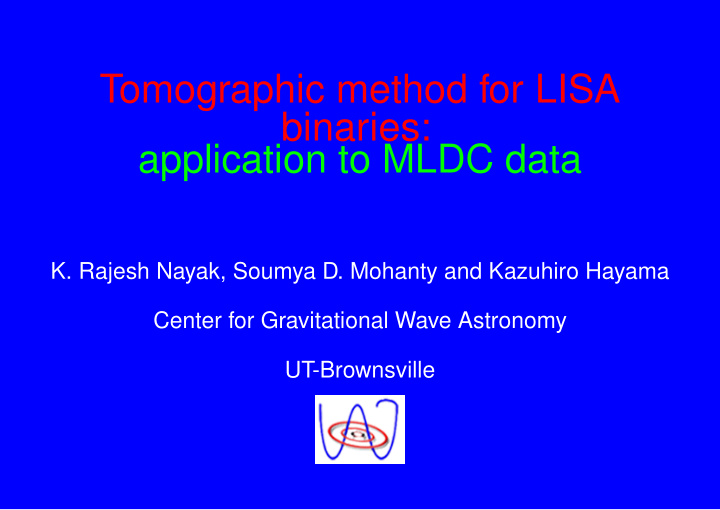



Tomographic method for LISA binaries: application to MLDC data K. Rajesh Nayak, Soumya D. Mohanty and Kazuhiro Hayama Center for Gravitational Wave Astronomy UT-Brownsville
Summary of Tomographic Method ☞ Motion of LISA around the Sun allows the relation between detector response and Radon transform. (S. D. Mohanty and R. K. Nayak, Phys. Rev. D 74, 044007 (2006)). ☞ The Inverse Radon transform on the LISA time series gives the sky map of gravitational wave sources at any given frequency. ☞ The resulting sky map is convolution of GW source distribution with the point spread function or PSF . ☞ Known PSF , we can search for isolated bright point source. ✍ Not a Template based method! ☞ Here we use visual inspection for identifying the point sources!
Inverse Radon Transform on the LISA time series One year Time Series t 0 t 2 t 1 t i 2−D, Fourier Domain ∆ − t 0 t 1 Smaller time series t = In polar coordinate 1−D FFT ψ ( k , ) ω t i 2−D Inverse Fourier transform SKY MAP
Visual Identification As an example, for MLDC data set 1.1.4, sky maps are plotted:
Visual Identification As an example, for MLDC data set 1.1.4, sky maps are plotted: Bright source
Visual Identification As an example, for MLDC data set 1.1.4, sky maps are plotted: Confusion because of overlapping PSF .
Visual Identification As an example, for MLDC data set 1.1.4, sky maps are plotted: Source lost because of near by bright source
Application to MLDC 1.1.1-1.1.4 Summary: ☞ Sky maps are generated for every frequency bin in the band of interest. (1 bin = 1/one year). ☞ The frequency resolution is one bin (i.e < 31 nHz). ☞ error in sky position inversely proportional to the frequency. ☞ At present we can get only absolute value of latitude.
MLDC 1.1.1a-c The sky map at source frequency is :
MLDC 1.1.2 and 1.1.3 ☞ For source Identification: first, sky maps are constructed from frequency 0.5 mHz to 8 mHz. That is about 250000 sky maps! ☞ This is computationally expensive, because of larger number of bins involved. It took 15 Hrs on a standard 2.1 GHz Pentium desktop for a coarser sky resolution. ☞ Integrated sky maps are plotted as a function of frequency.
Plot of Integrated sky map vs power spectral density
Plot of Integrated sky map vs power spectral density
☞ Once source frequencies are known, their sky position can be obtained from full sky map. Errors in sky positions for MLDC 1.1.3
MLDC 1.1.4 ☞ Sky maps are computed for 500 frequency bins starting from 3 mHz. ☞ Computational cost is about 1 Hr on Desktop with better sky resolution. ☞ We identified 36 sources, ✍ 24 source frequency matched with MLDC key values within one bin ✍ 3 source frequency matched with MLDC key values within two bin ✍ 9 source frequency did not match with MLDC ☞ 1 in 5 sources were wrong identification. This may be avoided with a proper deconvolution methods.
Error in sky position for MLDC 1.1.4
Amplitude distribution of detected sources ☞ The overlap of side lobes are bigger problem than SNR.
Effects Amplitude modulation ☞ Error in latitude is systematic not Random ☞ This is because of sub-optimal treatment of amplitude modu- lation. ☞ This error is larger as we get closer to Ecliptic plane. we use the optimized TDI data combinations, to get better localization of source position f + = cos χ E − sin χ A , f × = sin χ E + cos χ A , χ = 2 φ + π 3
Conventions and Notations! Signal generated with our code and MLDC parameters:
Conventions and Notations! Signal generated with our code and MLDC parameters: This optimization scheme has problems: MLDC 1.1.4 signal:
What we learned from MLDC ☞ We can identify the sources with frequency errors less than one bin corresponding to one year observation time. ☞ Errors in sky positions are systematic. ✍ Errors are due to sub-optimal treatment of amplitude modu- lation. ✍ This may be improved in the next step (MLDC 2 ?). ✍ We get absolute value of latitude. ☞ Deconvolution methods are needed for reducing false sources and to reduce the effect of bright sources.(Talk by Hayama).
Recommend
More recommend